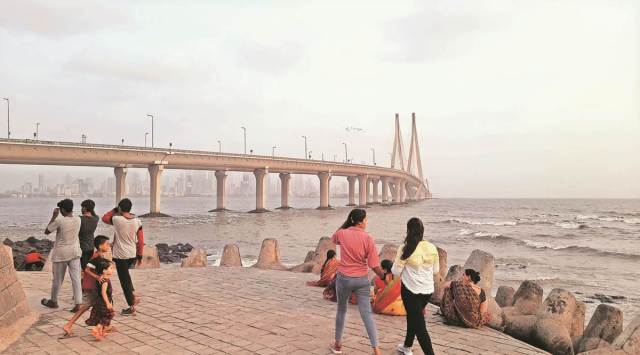- India
- International
After 3 months, city’s air quality slips to ‘very poor’ category again
According to the forecast, the AQI in the country’s commercial capital is likely to remain in the ‘red’ or ‘very poor’ category on Friday.
 An AQI between 100 and 199 is considered ‘moderate’, 50 and 99 ‘satisfactory’ and below 50 ‘good’. (Express Photo)
An AQI between 100 and 199 is considered ‘moderate’, 50 and 99 ‘satisfactory’ and below 50 ‘good’. (Express Photo)After nearly three months, the city’s Air Quality Index (AQI) climbed to the ‘very poor’ category on Thursday. According to the System of Air Quality Weather Forecasting And Research (SAFAR), the city’s AQI was 309 (very poor) on Thursday. The average AQI of Mumbai on Thursday was higher than Delhi (191) while Pune and Ahmedabad recorded 276 and 297 on the index respectively.
According to the forecast, the AQI in the country’s commercial capital is likely to remain in the ‘red’ or ‘very poor’ category on Friday. The AQI is likely to be in the ‘very poor’ and ‘upper end of poor’ range over the next two days, stated SAFAR. Except for Worli, all weather stations in the city recorded ‘very poor’ AQI on Thursday. Malad was the city’s most polluted with an AQI of 353.
An AQI between 100 and 199 is considered ‘moderate’, 50 and 99 ‘satisfactory’ and below 50 ‘good’. Across the state, the share of ‘good air quality days’ in 2020-21 was 32 per cent, while no ‘very poor or severe air quality days’ were recorded. An AQI over 200 is considered ‘poor’, above 300 ‘very poor’, above 400 ‘severe’ and above 500 ‘severe +’.
The AQI is a mean of pollutants such as particulate matter (PM2.5 and PM10), ozone (O3), nitrogen dioxide (NO2), sulphur dioxide (SO2) and carbon monoxide (CO) emissions as a single value. The higher the AQI value, the greater the level of air pollution and health concern.
It is recorded by SAFAR by integrating the measurement of air quality with weather forecasts.

Experts said the rise in pollution levels is due to two extreme weather conditions. Dr Gufran Beig, founder and project director of SAFAR, said, “The wind dust from the Thar region is unable to cross the low-pressure area along the Mumbai coast, leaving Mumbai and Pune highly polluted. There is a high temperature in the northern sphere and lower temperature following pre-monsoon showers in the southern part. The dust and smoke are hanging closer to the surface.”
Apr 26: Latest News
- 01
- 02
- 03
- 04
- 05







































